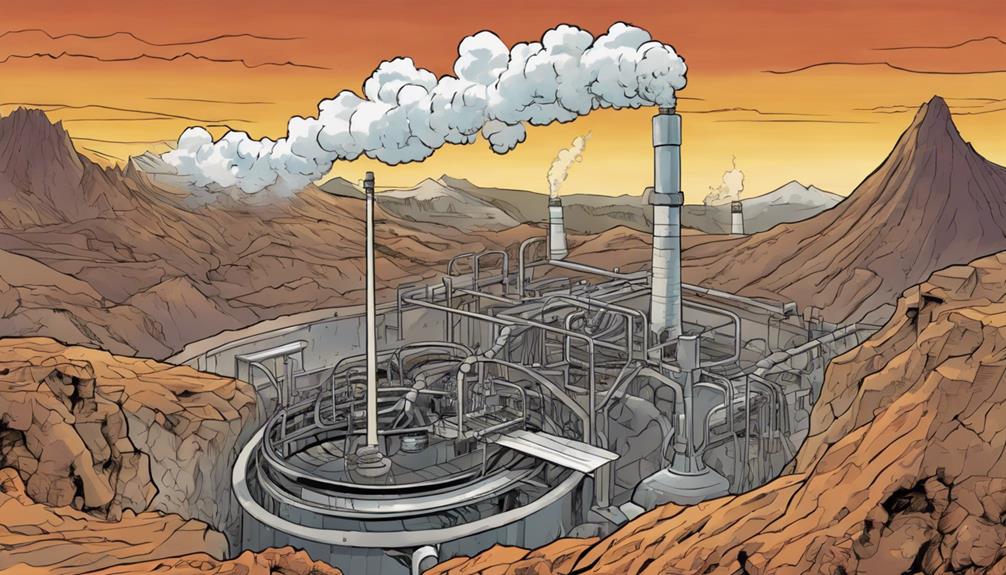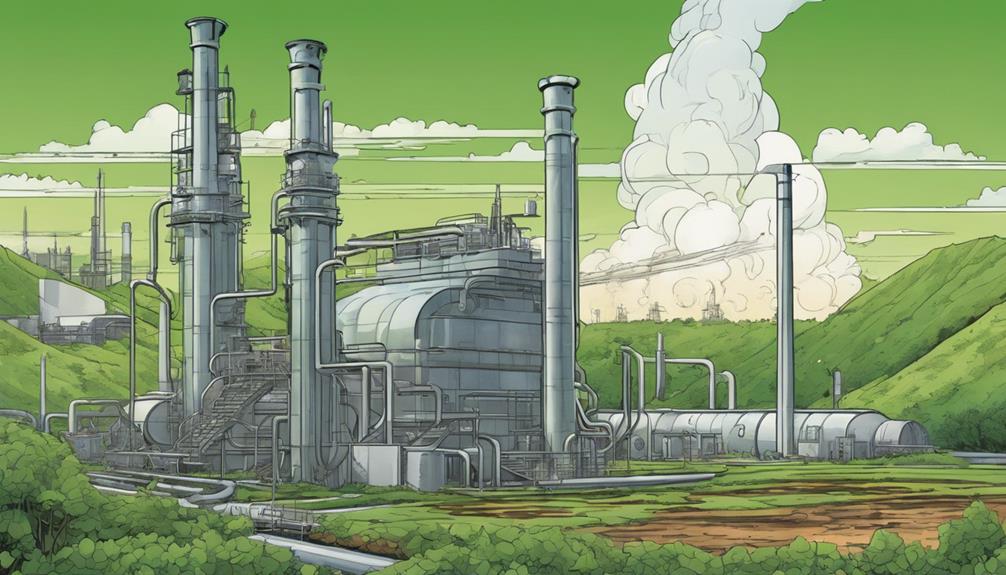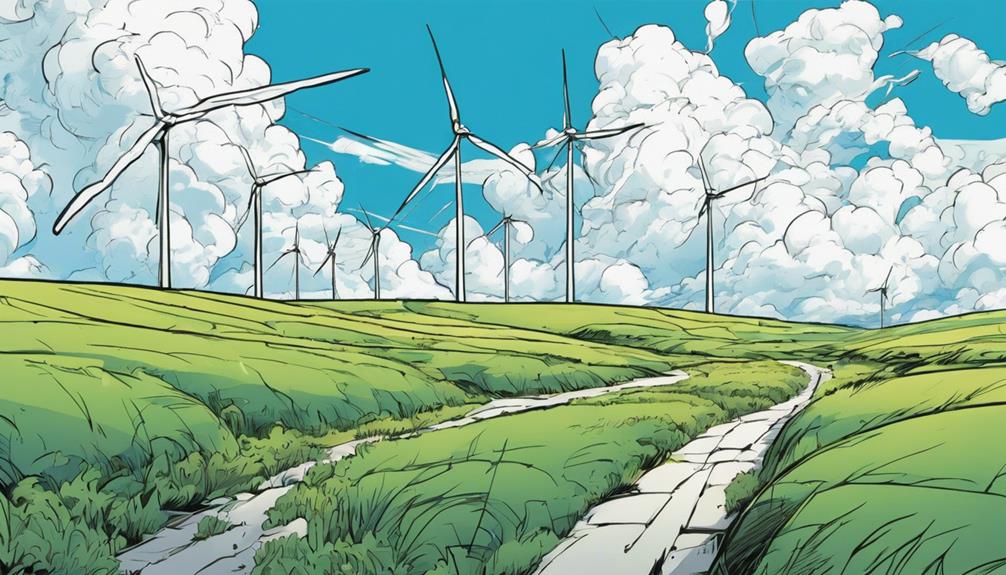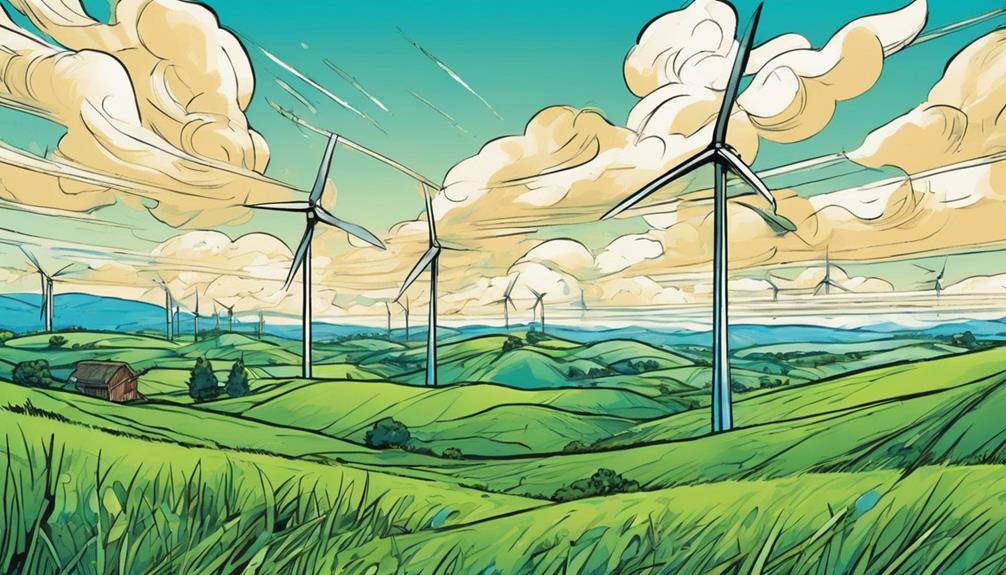We're excited about geothermal power, a renewable energy source that harnesses heat from the Earth's core. It offers a promising alternative to fossil fuels, with stable production costs ranging from $0.04 to $0.10 per kilowatt-hour. Geothermal power plants boast high efficiency rates, exceeding 90% capacity factor and 20% energy conversion efficiency. Plus, they have versatile applications for heating and cooling. While there are challenges to contemplate, like initial investment and technical expertise, the benefits are clear. Let's explore further to uncover the full potential of this sustainable energy source.
Key Takeaways
- Geothermal power plants have a high capacity factor exceeding 90% and energy conversion efficiency ranges from 10% to 23%.
- Initial investment costs range from $2 million to $7 million per megawatt, with operational and maintenance costs of $0.01 to $0.03 per kilowatt-hour.
- Geothermal energy is renewable and sustainable, with minimal greenhouse gas emissions and a long operational life exceeding 30 years.
- Co-generation systems can reach overall efficiencies of over 80%, and binary cycle power plants can achieve efficiencies up to 20%.
- Geothermal energy has versatile applications for heating and cooling, with reliable and stable power production, but requires significant initial investment and technical expertise.
Cost Analysis of Geothermal Energy

When it comes to geothermal energy production, we're looking at initial investment costs ranging from $2 million to $7 million per megawatt of electrical capacity, which can be a significant upfront expense.
However, operational and maintenance costs are relatively low, typically amounting to $0.01 to $0.03 per kilowatt-hour.
The levelized cost of electricity (LCOE) from geothermal power plants ranges from $0.04 to $0.10 per kilowatt-hour, making it a competitive option.
We should also consider the substantial development costs of Enhanced Geothermal Systems (EGS) technology, which can range from $10 million to $100 million.
Despite these costs, geothermal energy production costs are relatively stable compared to fossil fuels, as they're not affected by fuel price fluctuations.
Geothermal Potential and Efficiency

We're now turning our attention to the vast potential and impressive efficiency displayed by geothermal energy, with an estimated global capacity of around 35 gigawatts for identified resources.
Geothermal power plants boast a high capacity factor, often exceeding 90%. This means they can operate at or near full capacity for a significant portion of the time.
Concerning energy conversion efficiency, geothermal plants typically range from 10% to 23%. Binary cycle power plants, a common type, can achieve efficiencies of up to 20%.
Co-generation systems that utilize both electricity and heat can reach overall efficiencies of over 80%. These impressive efficiency rates make geothermal energy an attractive option for a sustainable future.
Advantages and Applications

Geothermal energy offers a multitude of advantages, including its renewable and sustainable nature. It produces minimal greenhouse gas emissions, making it an attractive alternative to fossil fuels.
We appreciate that geothermal power plants have a long operational life, typically exceeding 30 years. They provide reliable and stable power, unaffected by weather conditions or fuel price fluctuations.
We also recognize the versatility of geothermal systems, which can provide heating and cooling for residential, commercial, and industrial applications.
Moreover, geothermal energy extraction processes have a small land footprint compared to other energy sources, making them an environmentally friendly option.
Challenges and Considerations

Despite its numerous advantages, geothermal energy production faces several challenges and aspects that must be addressed to fully utilize its potential.
We must recognize that geothermal energy exploration and development require significant initial investment and technical expertise. Furthermore, the availability of suitable geothermal resources is limited to specific regions with favorable geological conditions.
We also need to take into account the risk of induced seismicity and subsurface water contamination, which can present significant challenges to geothermal energy production.
Additionally, geothermal power plants may encounter operational issues related to scaling, corrosion, and mineral deposition.
These challenges underscore the need for thorough planning, comprehensive research, and collaboration to overcome the obstacles and fully realize the potential of geothermal energy.
Exploration and Drilling Expenses

Identifying potential geothermal sites and drilling into the Earth's crust to tap into this energy source comes at a significant cost, with various techniques and equipment requiring substantial investments.
We use techniques like gravity surveys and seismic surveys to identify geothermal potential, which can be costly, ranging from thousands to millions of dollars.
Drilling equipment costs can range from hundreds of thousands to millions of dollars. These investments are necessary to tap into geothermal energy potential.
We must carefully select sites, design and engineer the project, obtain permits, and construct the power plant. Each step requires significant funding, but the payoff is a reliable and sustainable source of energy.
Geothermal Energy Production Costs

We're looking at initial investment costs for geothermal energy production that range from $2 million to $7 million per megawatt of electrical capacity. These upfront costs can be substantial, but they're a necessary step in harnessing this renewable energy source.
Once operational, geothermal power plants have relatively low operational and maintenance costs, typically between $0.01 and $0.03 per kilowatt-hour. The levelized cost of electricity (LCOE) from geothermal power plants ranges from $0.04 to $0.10 per kilowatt-hour.
While Enhanced Geothermal Systems (EGS) technology development costs can be high, up to $100 million, the long-term benefits of geothermal energy production make it an attractive option for those willing to invest.
Plant Construction and Operations

We construct geothermal power plants in areas with suitable geothermal resources, securing efficient operations through careful site selection, design, and engineering.
After identifying a promising site, we invest in exploration and drilling to tap into the geothermal energy potential. This involves using techniques like gravity surveys and seismic surveys to locate underground reservoirs.
Drilling equipment costs can range from hundreds of thousands to millions of dollars. Once the wells are drilled, we build the power plant, which includes installing turbines, generators, and other necessary infrastructure.
We also implement measures to minimize operational issues like scaling, corrosion, and mineral deposition. By carefully planning and executing these steps, we can secure the long-term reliability and efficiency of our geothermal power plants.
Frequently Asked Questions
How Does Geothermal Energy Production Impact Local Ecosystems and Biodiversity?
We acknowledge that geothermal energy production can have environmental implications, potentially affecting local ecosystems and biodiversity through induced seismicity, water contamination, and land use changes, which must be carefully managed.
Can Geothermal Energy Be Used for Industrial Process Heat Applications?
We harness geothermal energy to power industrial processes, juxtaposing fiery heat with icy cool efficiency. Yes, geothermal systems can provide reliable, high-temperature heat for various industrial applications, such as food processing and paper manufacturing.
What Role Does Government Policy Play in Geothermal Energy Development?
We believe government policy plays an essential role in geothermal energy development, as supportive regulations, incentives, and funding can overcome exploration and drilling costs, technical challenges, and public perception hurdles, driving growth.
How Does Geothermal Energy Compare to Other Renewable Energy Sources?
"We're stunned that geothermal energy can provide 35 GW of power globally Did you know it outperforms solar and wind in capacity factor, often exceeding 90%? Geothermal's reliability and efficiency make it a compelling renewable energy source."
Are There Any Successful Geothermal Energy Projects in Developing Countries?
We've seen successful geothermal energy projects in developing countries like Kenya, where the Olkaria III plant generates 105 MW, and Indonesia, where the Wayang Windu plant produces 227 MW, showcasing geothermal's potential in emerging markets.
What Are the Efficiency and Costs of Using Geothermal Energy for Vehicle Power?
When it comes to using geothermal for cars, the efficiency and costs are relatively low compared to traditional fossil fuel-powered vehicles. Geothermal energy is a sustainable and renewable source of power, which means it has the potential to significantly reduce carbon emissions and reliance on non-renewable resources for vehicle power.
Conclusion
As we wrap up our journey through the world of geothermal power, we're left with a sense of excitement and hope.
Like a treasure chest overflowing with golden opportunities, geothermal energy offers a wealth of benefits – from low operational costs to high capacity factors.
While challenges persist, the advantages of this renewable energy source shine bright, illuminating a path towards a cleaner, more sustainable future.










